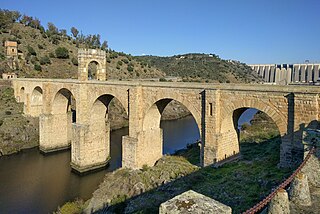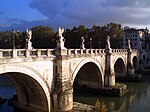
The Guadalquivir is the fifth-longest river in the Iberian Peninsula and the second-longest river with its entire length in Spain. The Guadalquivir is the only major navigable river in Spain. Currently it is navigable from the Gulf of Cádiz to Seville, but in Roman times it was navigable to Córdoba.

The Manzanares is a river in the centre of the Iberian Peninsula, which flows from the Sierra de Guadarrama, passes through Madrid, and eventually empties into the Jarama river, which in turn is a right-bank tributary to the Tagus.

The Alconétar Bridge, also known as Puente de Mantible, was a Roman segmental arch bridge in the Extremadura region, Spain. The ancient structure, which featured flattened arches with a span-to-rise ratio of 4–5:1, is one of the earliest of its kind. Due to its design, it is assumed that the bridge was erected in the early 2nd century AD by the emperors Trajan or Hadrian, possibly under the guidance of Apollodorus of Damascus, the most famous architect of the time.

The Alcántara Bridge is a Roman bridge at Alcántara, in Extremadura, Spain. Alcántara is from the Arabic word al-Qantarah (القنطرة) meaning "the arch". The stone arch bridge was built over the Tagus River between 104 and 106 AD by an order of the Roman emperor Trajan in 98.

Algete is a town and municipality in central Spain. It lies in the comarca de Alcalá in the autonomous community of the Community of Madrid. It had a population of 19,345 in 2008. Algete is 30 kilometres (19 mi) northeast of the capital.

The Puente Romano is a Roman bridge over the Guadiana River at Mérida in southwest Spain.

The Sixaola River is a river in southern Limón Province, Costa Rica. It flows from the Cordillera Talamanca to the Caribbean Sea northeast of Sixaola at 9°34′20″N82°33′54″W. The river's headwaters are part of the La Amistad International Park. For part of its length, the river forms the border between Limón Province, Costa Rica and Bocas del Toro Province, Panama.

Talamanca de Jarama is a municipality of the Community of Madrid, Spain.

Valdepiélagos is a municipality of the Community of Madrid, Spain. It received the title of villa (town) on 3 May 1801.

Segura Bridge is a Roman bridge connecting Segura, in Idanha-a-Nova, Portugal, to the Spanish municipality of Alcántara. The bridge was built over the Erges river, a tributary of the Tagus. It has five arches; only two of the original Roman arches, the ones closer to both river banks, survive to this day, with the rest being added during reconstructions in the 16th and 19th centuries. The stonemason work done during the 1571 reconstruction of two of the arches is considered to be "barely distinguishable" from the original.

The Puente de Alcántara is a Roman arch bridge in Toledo, Spain, spanning the Tagus River. The word Alcántara comes from Arabic القنطرة (al-qanţarah), which means "arch".

The Ruins of Talamanca are an archaeological site located in Talamanca de Jarama, Spain. It was declared Bien de Interés Cultural in 1931.

The Albarregas Roman bridge is a Roman bridge located in Mérida, Spain. The bridge, which is built of granite, crosses the river Albarregas, a tributary of the Guadiana. It is part of the Vía de la Plata.

The Roman bridge of Salamanca, also known as Puente Mayor del Tormes is a Roman bridge crossing the Tormes River on the banks of the city of Salamanca, in Castile and León, Spain. The importance of the bridge as a symbol of the city can be seen in the first quartering of city's coat of arms. It has been known traditionally as puente mayor and as puente prinçipal which gives access to the southern part of the city. The bridge as it currently appears is a result of several restorations. One of the disasters that most affected it was the Flood of San Policarpo on the night of January 26, 1626. It was declared Artistic Historic Monument on June 3, 1931, and Bien de Interés Cultural since 1998. Until the beginning of 20th century it carried the main road into the city, and continued to bear heavy traffic until 1973. After the construction of a third bridge for road traffic it remains exclusive for pedestrians.
National Primary Route 36, or just Route 36 is a National Road Route of Costa Rica, located in the Limón province.

The Burgo Bridge(Puente del Burgo) is a medieval bridge, built over an older bridge of Roman origin, which crosses the Lérez River in the city of Pontevedra, Spain. It is on the route of the Portuguese Way. Between the arches above the pillars are carved the famous stone pilgrim's shells.

















